How to Make Tomato Juice With a Juicer

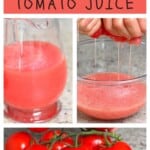



How to make tomato juice with and without a juicer with one of three methods: blending, grating, or juicing. The resulting homemade tomato juice takes just minutes to prepare and is fresh, packed with flavor, and perfect for whipping up cocktails or storing for later!
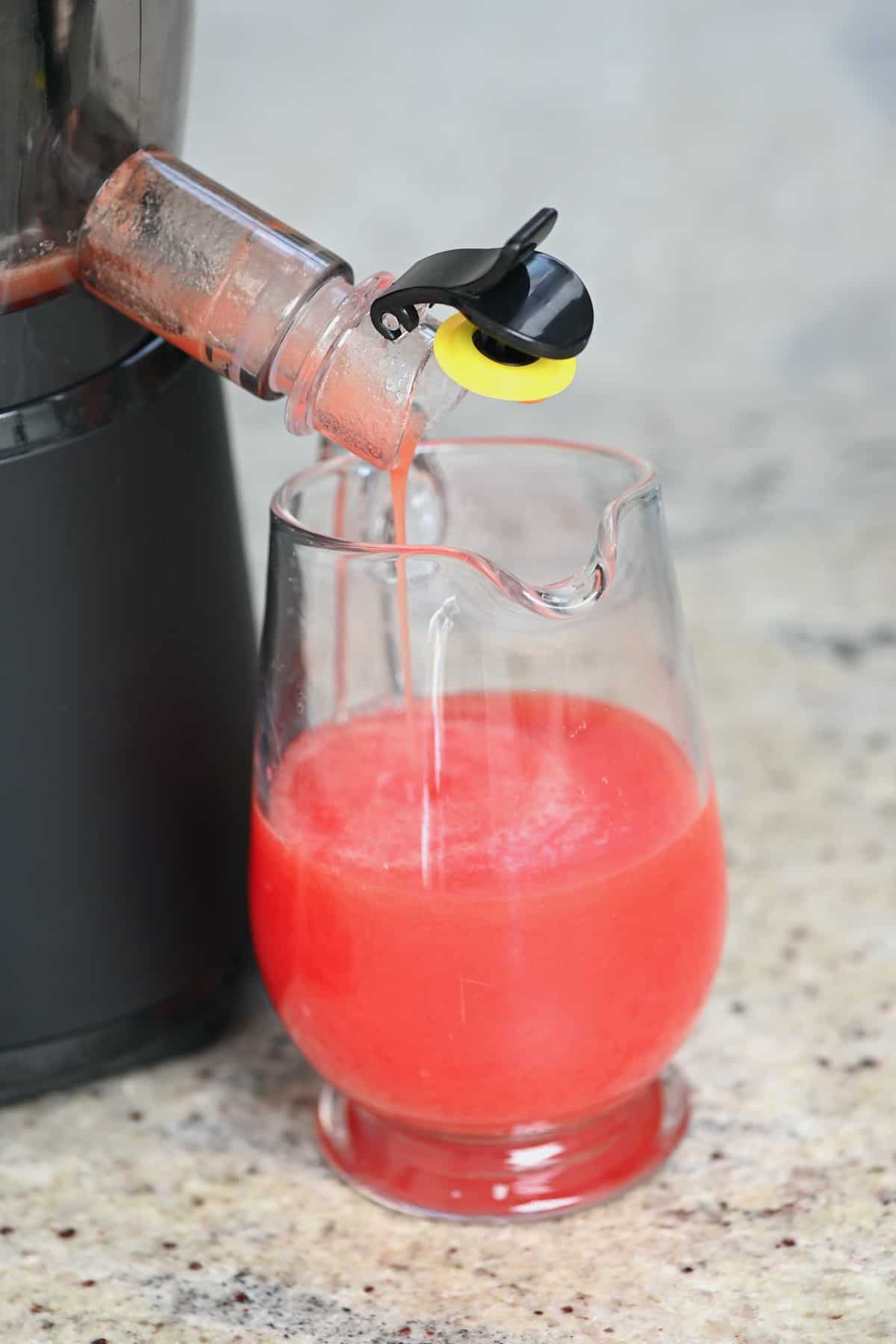
Whether you grow your own tomatoes and have had a particularly successful year or simply want to make some homemade tomato juice sans preservatives and any other 'nasties' – learning how to make tomato juice at home is simple and takes just minutes – with or without a juicer.
Below I've included three heat-free methods for tomato juicing, as well as the heated method (in the recipe notes). Having already shared how to juice cucumber, turmeric, watermelon, ginger, carrots, and orange, – it was only a matter of time before I added homemade tomato juice to the list.
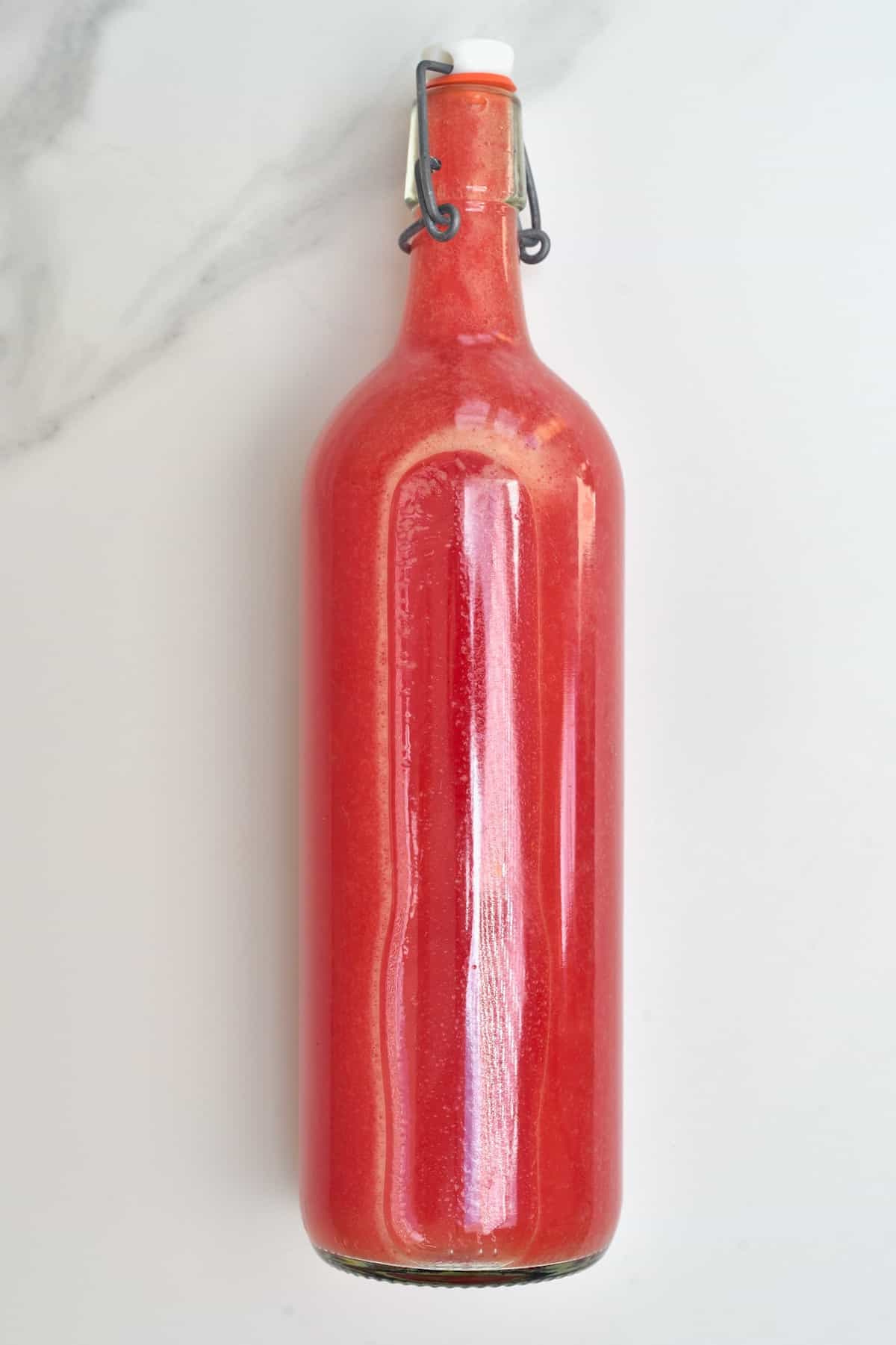
This year I've really found the time to embrace tomatoes in all their glory with dishes like Caprese salad, Pico de Gallo, cucumber and tomato salad, gazpacho, and more. Tomato juicing is just another thing to add to my kitchen repertoire; whether I want to whip up a virgin (or not) bloody Mary, add the juice to other juices and smoothies, sauces, or store for later – learning how to juice a tomato is simple and can be done in multiple ways. The resulting juice is packed with health benefits too!
The Benefits of Tomato Juice
Just like fresh tomatoes are packed with health benefits, the same can be said for tomato juice. Not only is it packed with several vitamins and minerals, but a single cup (240ml) of tomato juice contains nearly all the daily recommended vitamin C and over 20% of the daily Vit A.
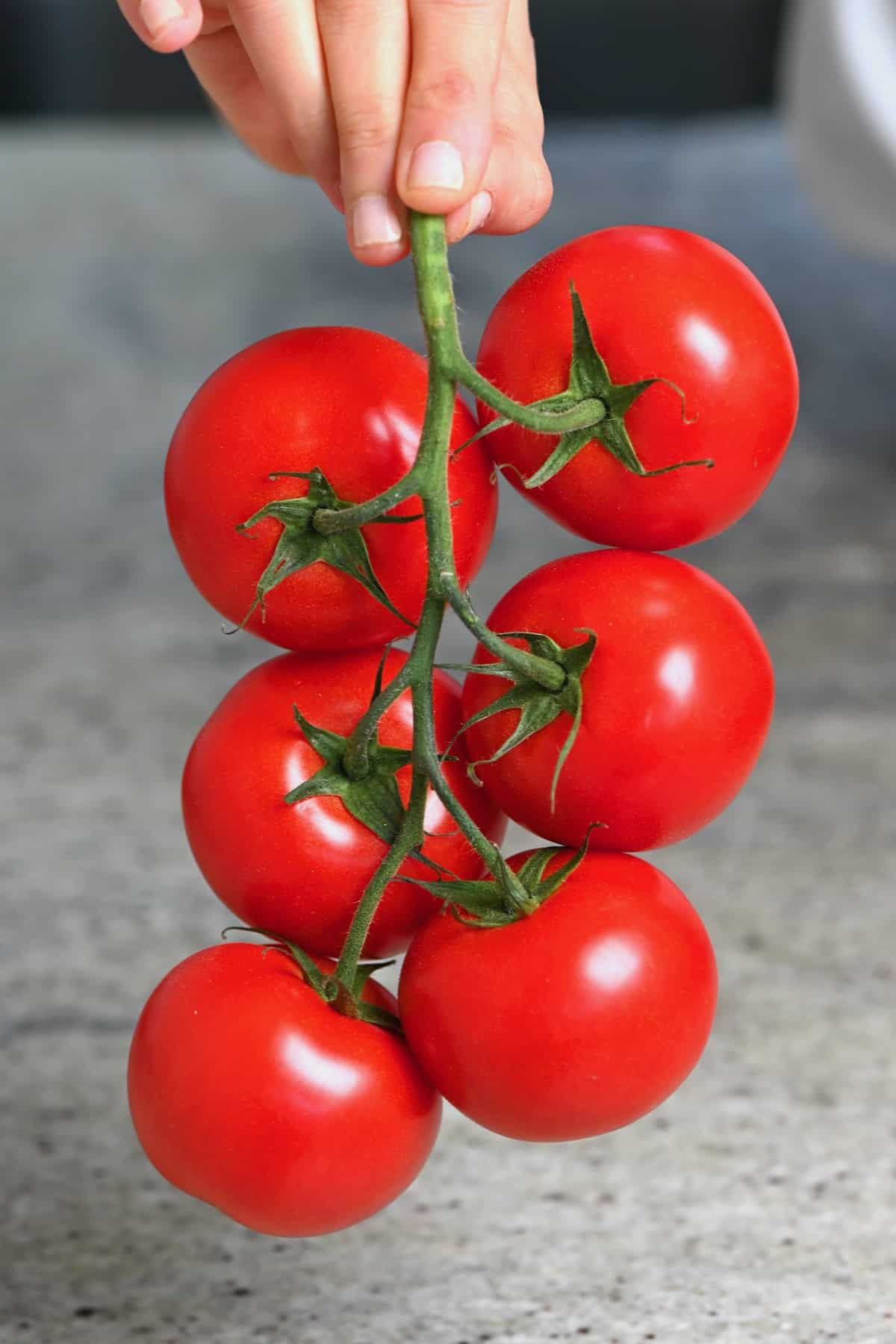
More so, tomato juice can improve eye and heart health, and the carotenoids within the juice act as a potent antioxidant, protecting against oxidative damage and reducing inflammation, and providing protection against certain cancers.
There is also some evidence that it may prevent blood clotting and contains vitamins and minerals that are good for bone and skin health while detoxifying our bodies by boosting liver and kidney function.
In fact, there have been several studies undertaken to explore the effects of drinking tomato juice daily on the human body.
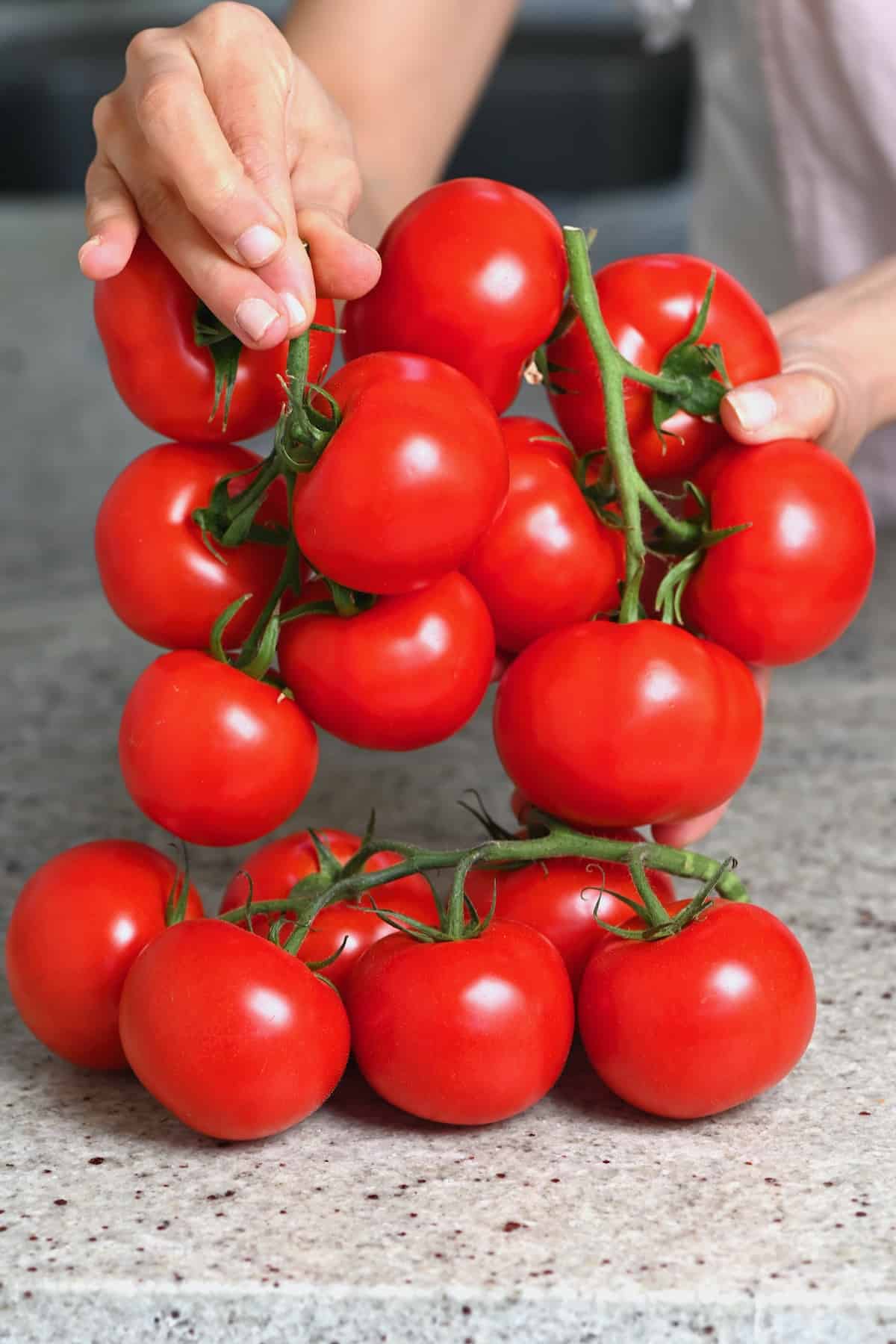
Unfortunately, many store-bought tomato juice options are also extremely high in sodium, which can negatively affect our health. That's where homemade tomato juice comes in!
How to Make Tomato Juice from Fresh Tomatoes
First, make sure to wash the tomatoes well and pat them dry. Depending on which method you plan to use, you may want to remove the tomato core, too.
Tomato Juicer Recipe
This method is the simplest of them all and requires no manual squeezing.
Chop the tomatoes, so they fit through the chute of your juicer.
Slowly feed them into the juicer – voila! The juicer will automatically remove the skin and seeds from the juice.
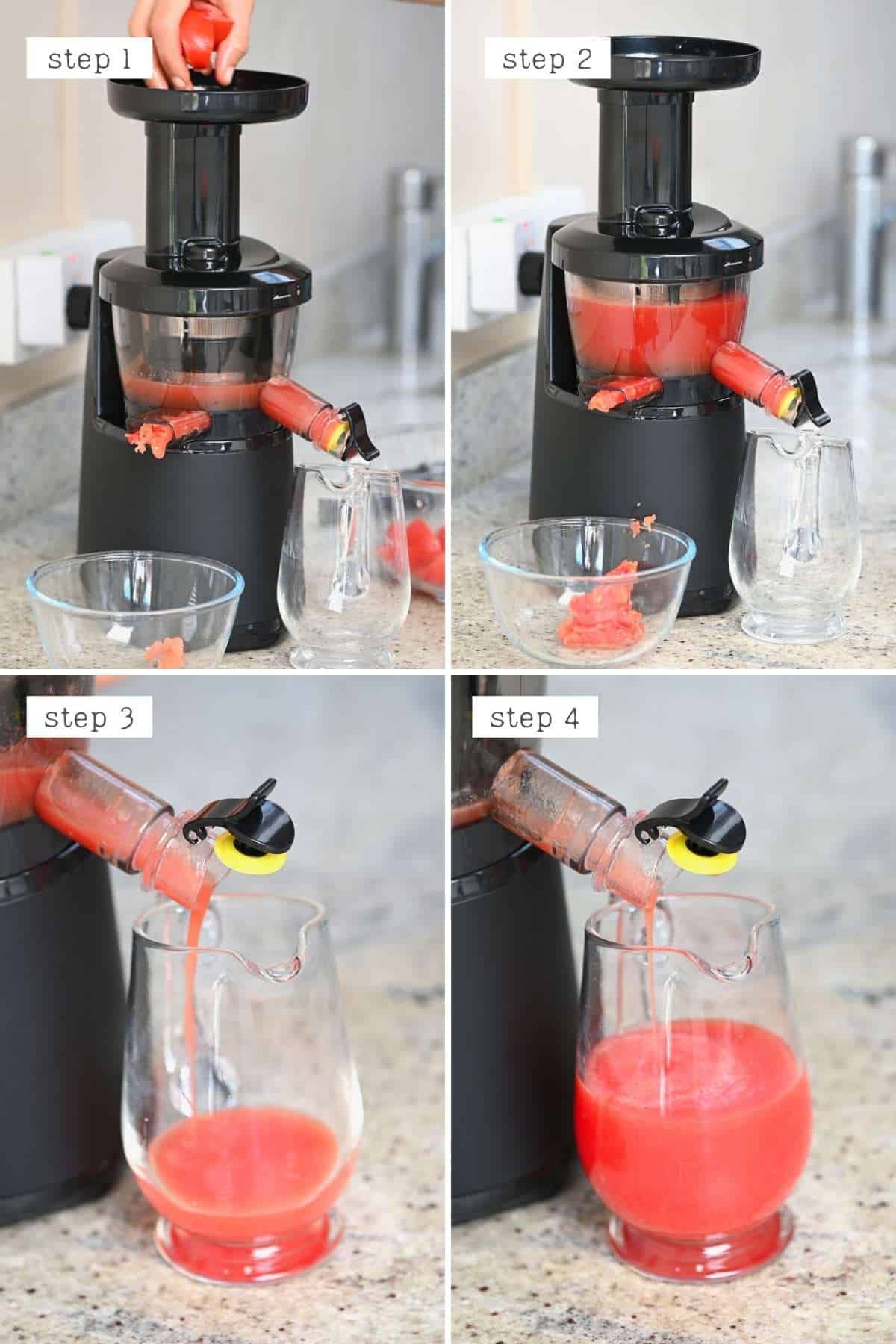
Tomato Juice in a Blender
First, chop the tomatoes into rough pieces (I did it whole this time, but it gave the machine more work to do and vibrated all over the place – whoops!).
Then blend until the mixture is juice-like and smooth – this may take a couple of minutes to properly break down.
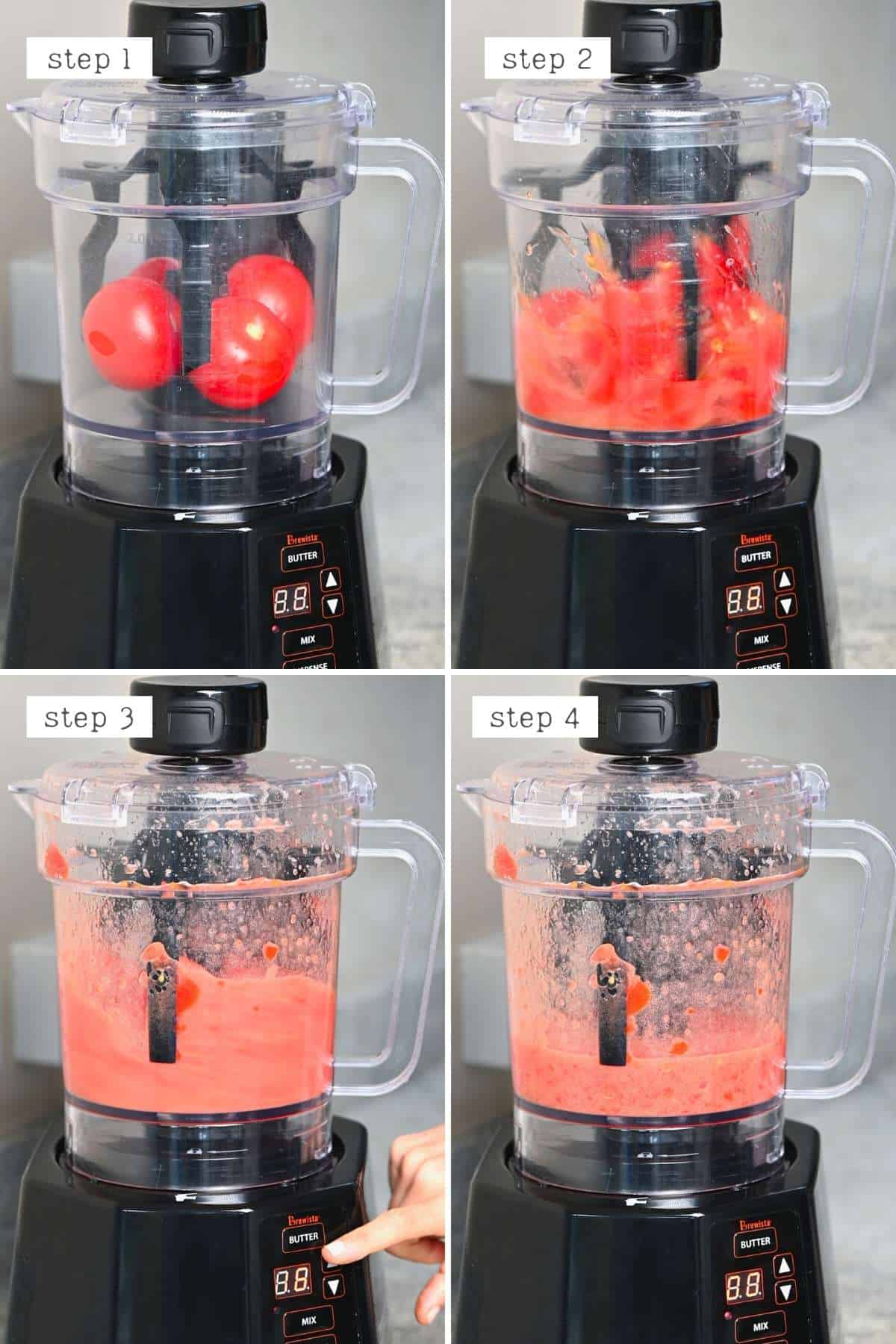
Place a large nut milk bag or layers of cheesecloth inside a large bowl (alternatively, use a sieve) and pour the tomato mixture from the blender into it. Lift the bag/cheesecloth up and allow it to drain naturally. Then, using your hands, squeeze the leftover pulp to remove as much juice as possible.
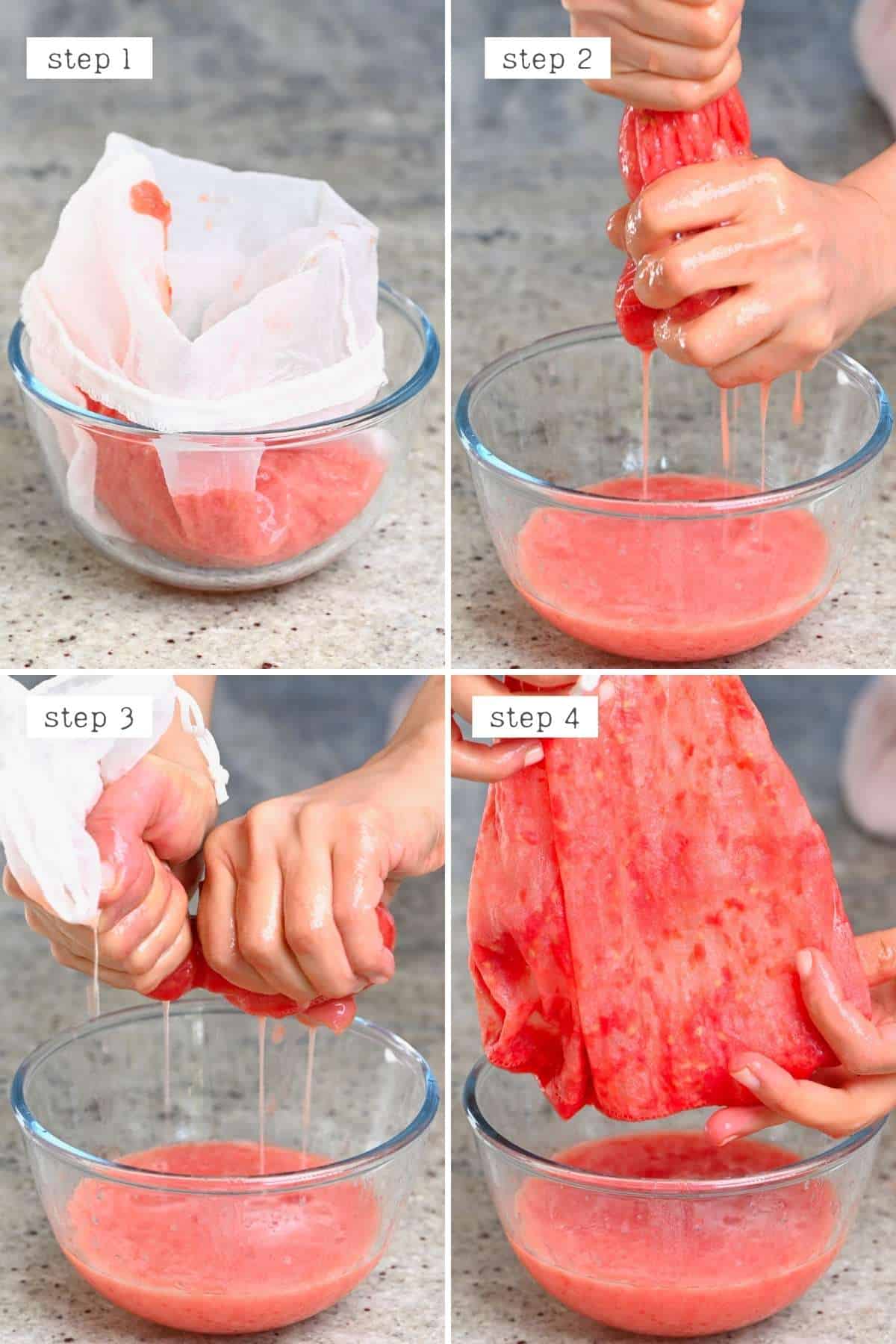
Tomato juicer with a grater
This option is machine-free and uses a similar method to the one for making cucumber juice.
Grate or chop the tomato as finely as possible into a large bowl, then transfer than mixture to a nut milk bag (or cheesecloth layers) and squeeze, squeeze, squeeze.
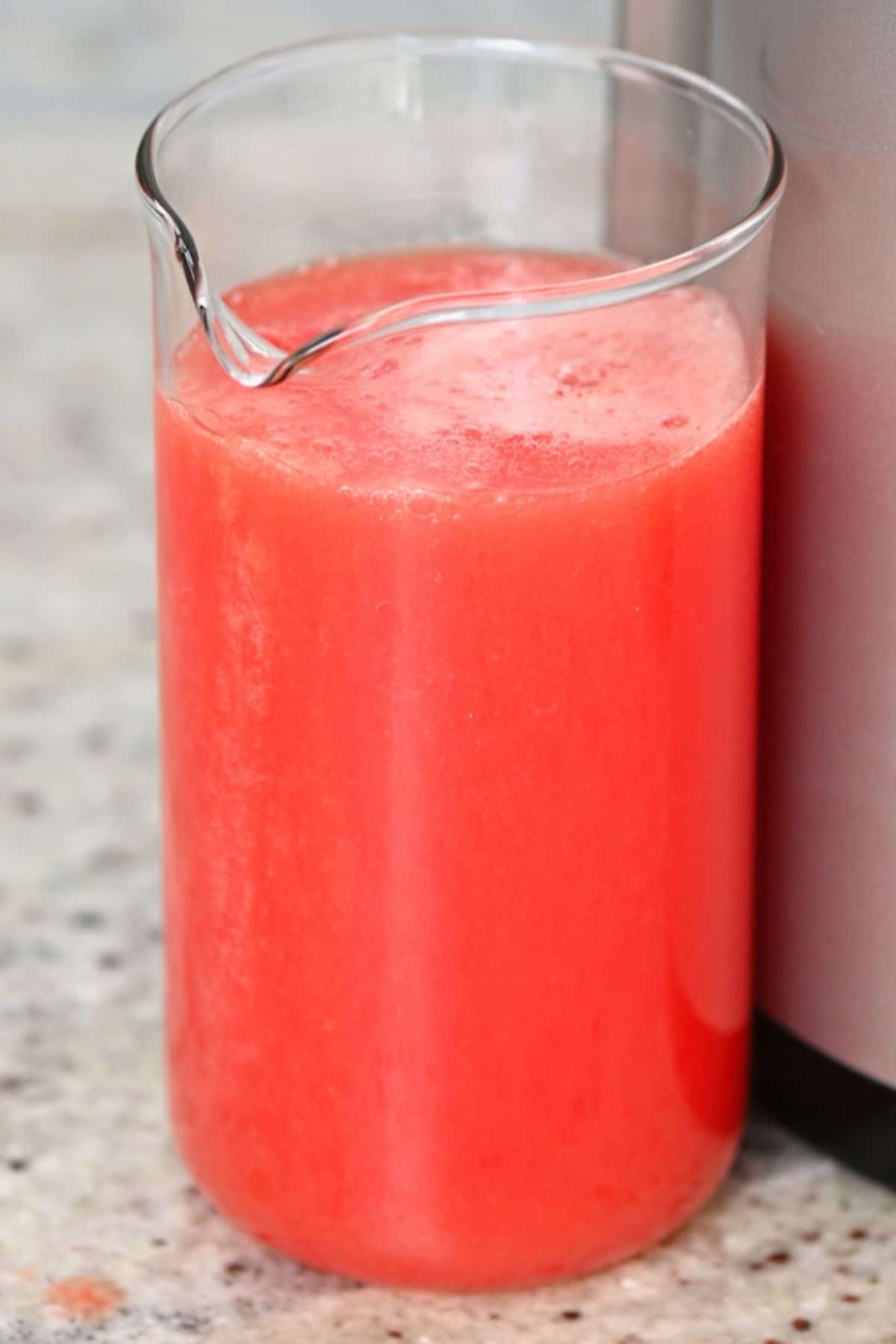
BONUS The Heated Method
Chop your tomatoes and add them to a large pan on the stovetop over medium heat with a splash of water. Simmer for 20-30 minutes. Continuously stirring to soften the tomatoes.
Then, press the softened tomatoes through a sieve or food mill to extract the juice and leave behind the skin and seeds.
Return the extracted juice to the stovetop and heat over medium heat until just before boiling (around 185-195ºF/85-90ºC- don't boil it!).
You can then can the juice or allow it to cool slightly before transferring to the refrigerator or freezer.
Why use the heated method? Heating them the first time will help to soften the tomatoes to extract as much juice as possible. The second heating will pasteurize the juice – it can also positively affect the juice's viscosity/texture and shelf life. More so, the flavor will change and become more concentrated. I recommend trying both methods to find your preferred version. While heating the tomatoes will reduce Vitamin C levels somewhat, the lycopene will become more easily absorbable.
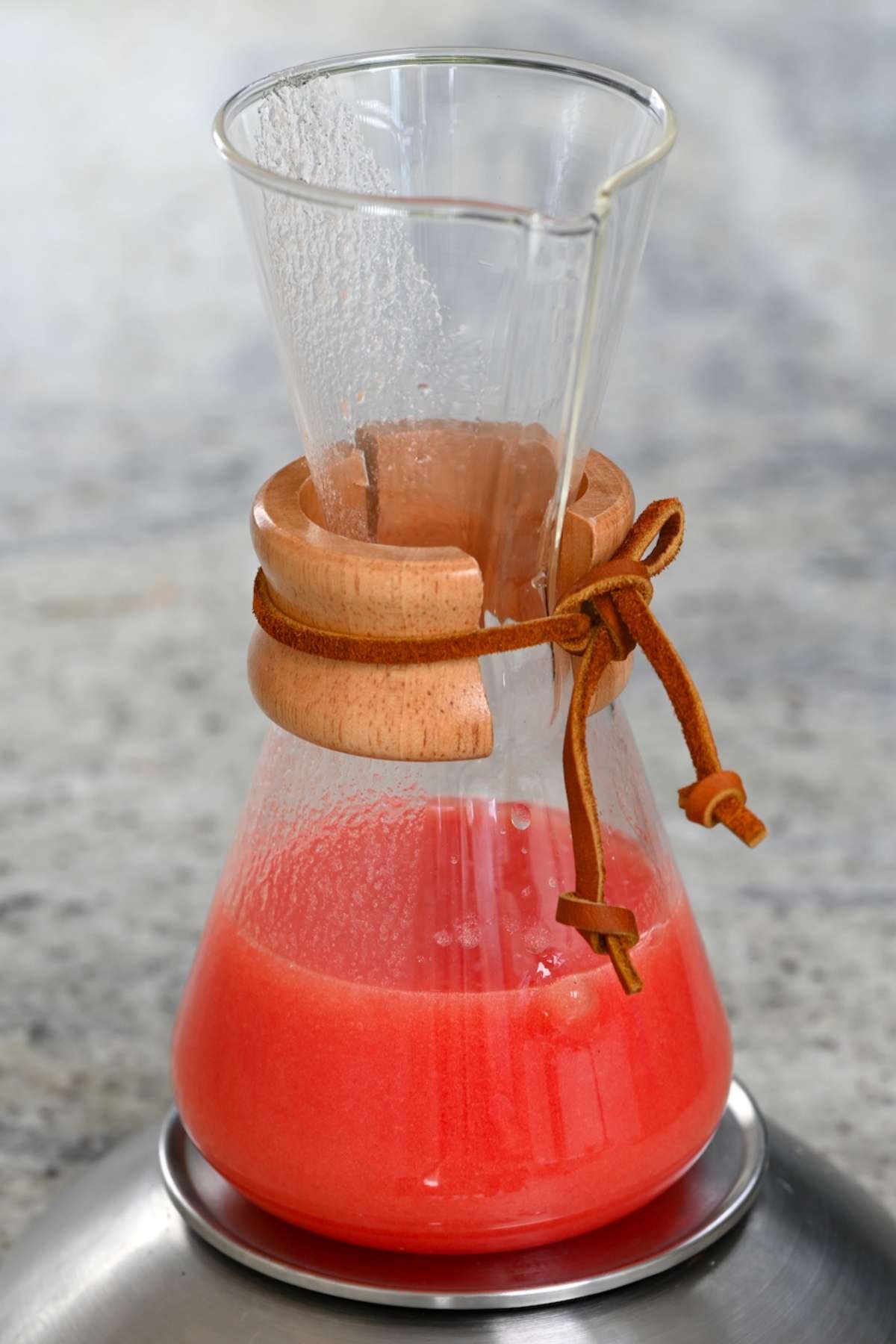
How to Water Bath Can Tomato Juice
I didn't design this recipe with canning tomato juice in mind, so it's best to refer to official sources for correctly processing tomato juice – like this tomato preservation PDF.
When canning tomato juice, you'll need to increase the acidity of the juice. To do this, start by adding 2 tablespoons of lemon juice per 1 quart of tomato juice and mix well (or 1 Tbsp per pint). Then, follow the below steps.
Sterilize the jars: Wash the jars and lids in hot soapy water, rinsing well. Then place the jars (no rubber or plastic parts) in a pre-heated oven for ten minutes at 325ºF/160ºC to completely dry them.
Note: some dishwashers have a 'sanitize' option, which will wash and sanitize them.
Pour the tomato juice into the jar/s, leaving ½-inch headspace (for expansion). It can be easiest to do this with a funnel to reduce the risk of any spillage.
Add the lids and seal them, wiping any spillages clean from the outside of the jars.
Process the cans: the time needed to process the jars will depend on the altitude where you live – follow these guidelines for the correct time.
Rest for 24hrs: after processing the jars, allow them to cool at room temperature for 24 hours. During this time, the jars should properly seal, and the 'button' in the center of the lid should be down, creating a flat cap. If any aren't properly sealed, you'll need to reprocess them or move them to the fridge/freezer to store for a shorter time.
Transfer to cupboard/freezer: you can then store away the jars of homemade tomato juice. Keep them labeled in a cool dark location for up to a year or in the freezer for up to 18 months.
Once opened, store the juice in the refrigerator and aim to use it within a week.
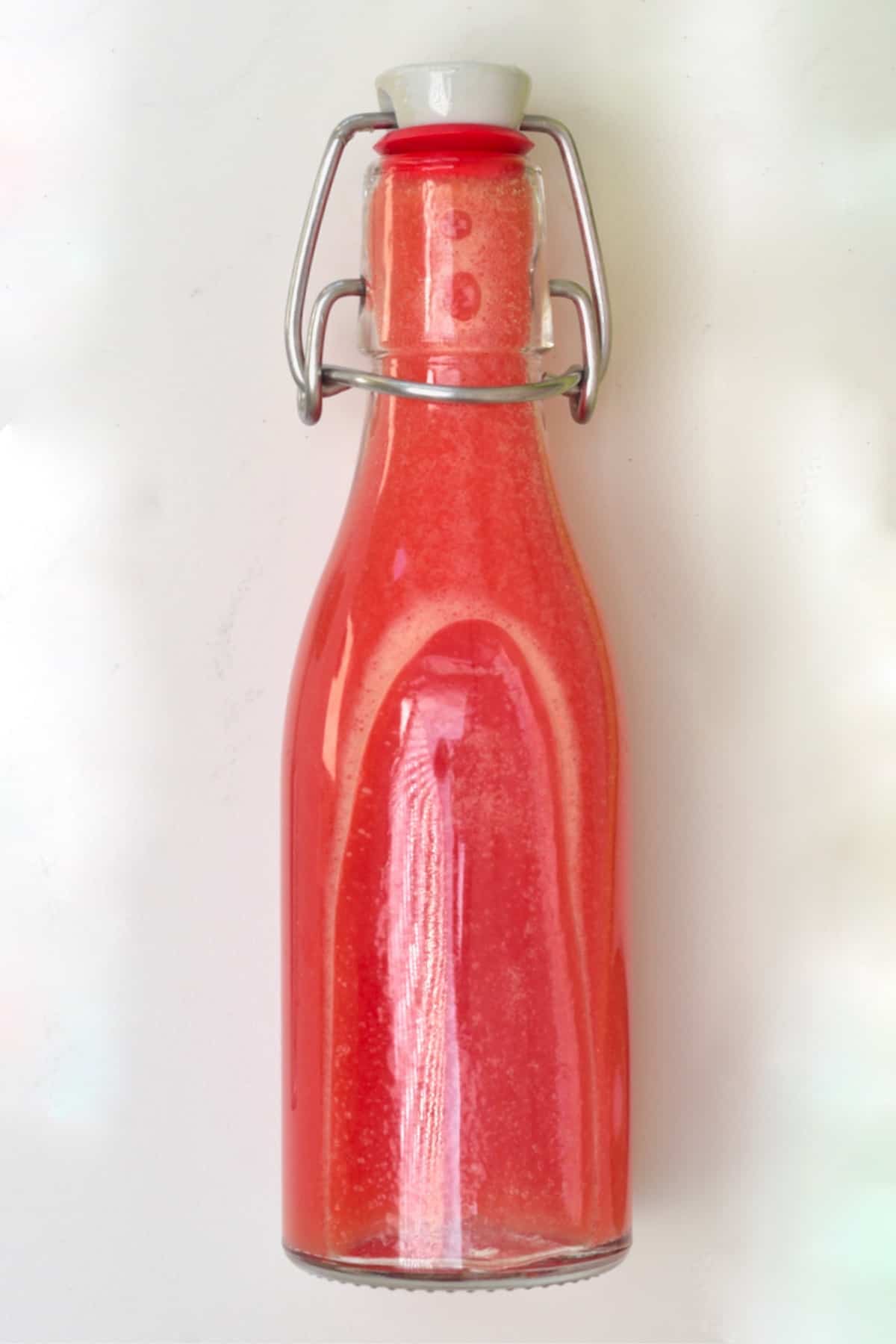
How to Use Tomato Juice
Aside from drinking the juice alone or as part of a blend, there are several other recipe options to use your homemade tomato juice, including:
- Bloody Mary: the classic choice, use this tomato juice for a homemade Bloody Mary (virgin or not!)
- Fizzy: add sparkling water or fizzy lemonade to the bloody Mary.
- Spicy tomato juice: if you're using a juicer, you can add a jalapeno or chili of your choice to the juice, based on how spicy you'd like it to be. Alternatively, you can add a little chili/cayenne pepper to the juice and mix well. When making spicy tomato juice, I like to also add celery and bell pepper to the juice.
- Mixed juice: there are several ways you can enjoy this tomato juice with other ingredients: orange, carrot, pear, melon, beetroot, cucumber, ginger, etc. Sweeten it with a bit of sugar or honey.
- Soup base: you can use it in place of, or as part of, a stock. You can also add some to gazpacho.
- Chili: you can also use leftover tomato juice in a chili instead of, or alongside, canned tomatoes.
- Add to grains: leftover tomato juice is excellent for adding to rice and grains to add more flavor, like Mexican rice. You can do the same for pasta.
- Smoothies/Shakes: blend a little tomato juice (or the ice cubes) into the drink of your choice.
- Add to stock: when making homemade veggie stock, you can add a little of the tomato juice for extra flavor.
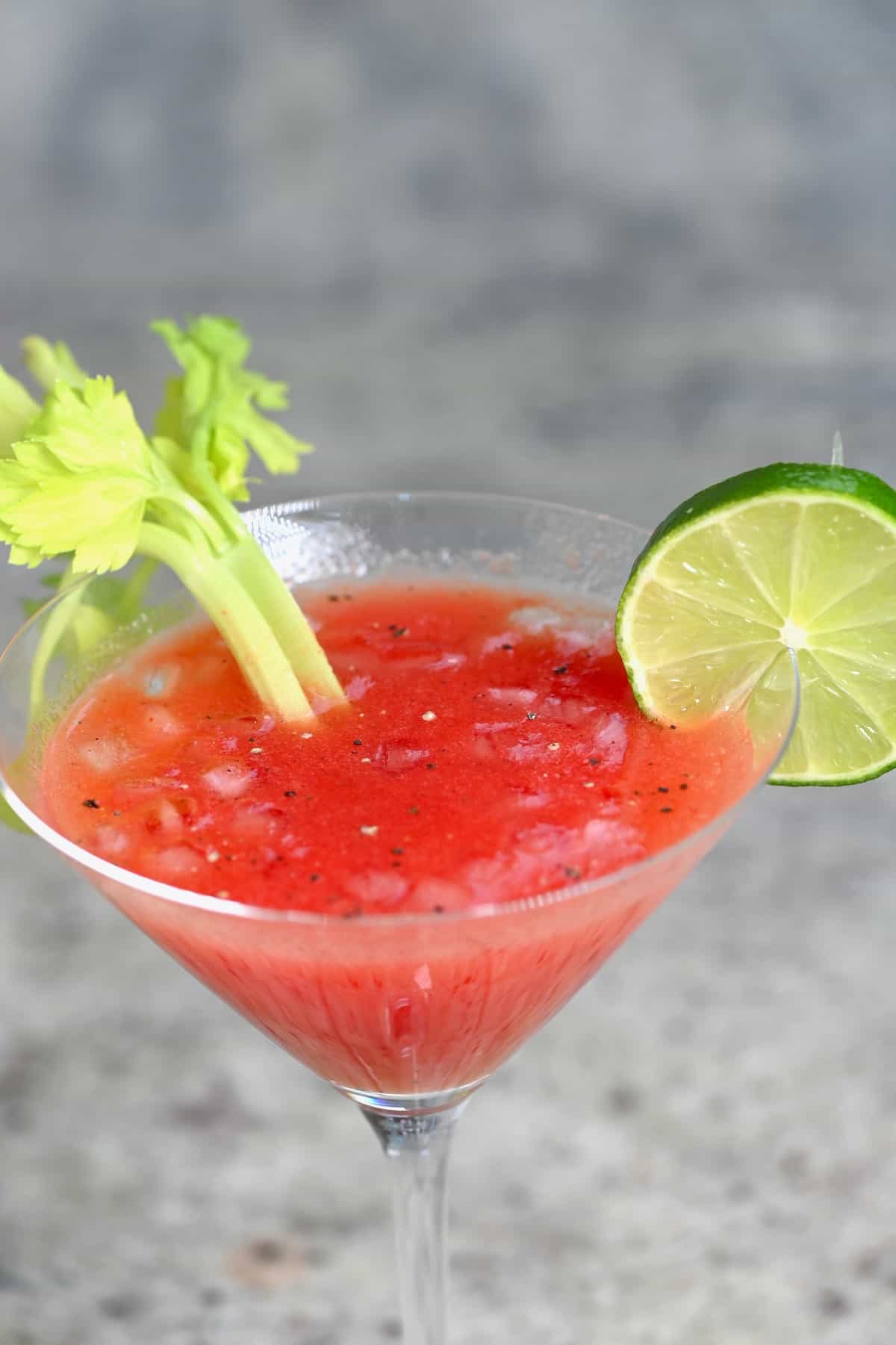
FAQs
Why is my homemade tomato juice watery/separating?
You may have noticed that store-bought tomato juice is often very smooth, velvety, and has an even texture throughout. Whereas homemade tomato juice can be watery and separate easily. This is due to the lack of pasteurization of the juice when using raw tomatoes – in fact, this is one reason that several tomato juice recipes contain a cooking element where the tomatoes are simmered before straining for juice.
However, you can enjoy the juice raw, too – just give it a good shake before drinking.
Can I drink tomato juice every day?
You sure can – as with everything, moderation is key. Unlike many juices, I also recommend not consuming tomato juice in the morning on an empty stomach. This is because it may cause gastrointestinal acid issues (especially to those already prone to them).
What can I use to season tomato juice?
There are tons of ways to jazz up this homemade tomato juice recipe. The simplest options include adding flavorings like cayenne/chili powder, hot sauce, paprika, onion or garlic powder, or celery salt as simple seasonings. Alternatively, you could add a simple combination of salt and pepper. Other flavors that pair well with tomato juice include:
– Celery/ celery salt,
– Bell pepper,
– Worcestershire sauce,
– Cucumber,
– Garlic,
– Vodka,
– Carrot,
– Chili/cayenne powder,
– Lime/lemon,
– Hot sauce,
– Basil/parsley.
How can I use the leftover tomato skins and seeds?
There are a few ways that you can avoid wasting the leftover tomato pulp from juicing tomatoes.
– First, the tomato skins can be saved to make veggie stock.
– You can also allow the skins to dry out (in the oven at the lowest temp for 2-3 hours, in a dehydrator, or room temp). Then use a food processor to process it into flakes or a coffee/spice grinder to grind it into a tomato powder. Use the powder as a seasoning over soups, stews, savory porridge, popcorn, etc. Top tip: add a little salt and sugar when grinding to enhance the flavor.
– Thirdly, you can fry up the skins until crispy to use as a dish garnish. Sprinkle over pasta, pizza, and salads.
– When it comes to using the tomato seeds – why not save them and plant them for more tomato plants?!
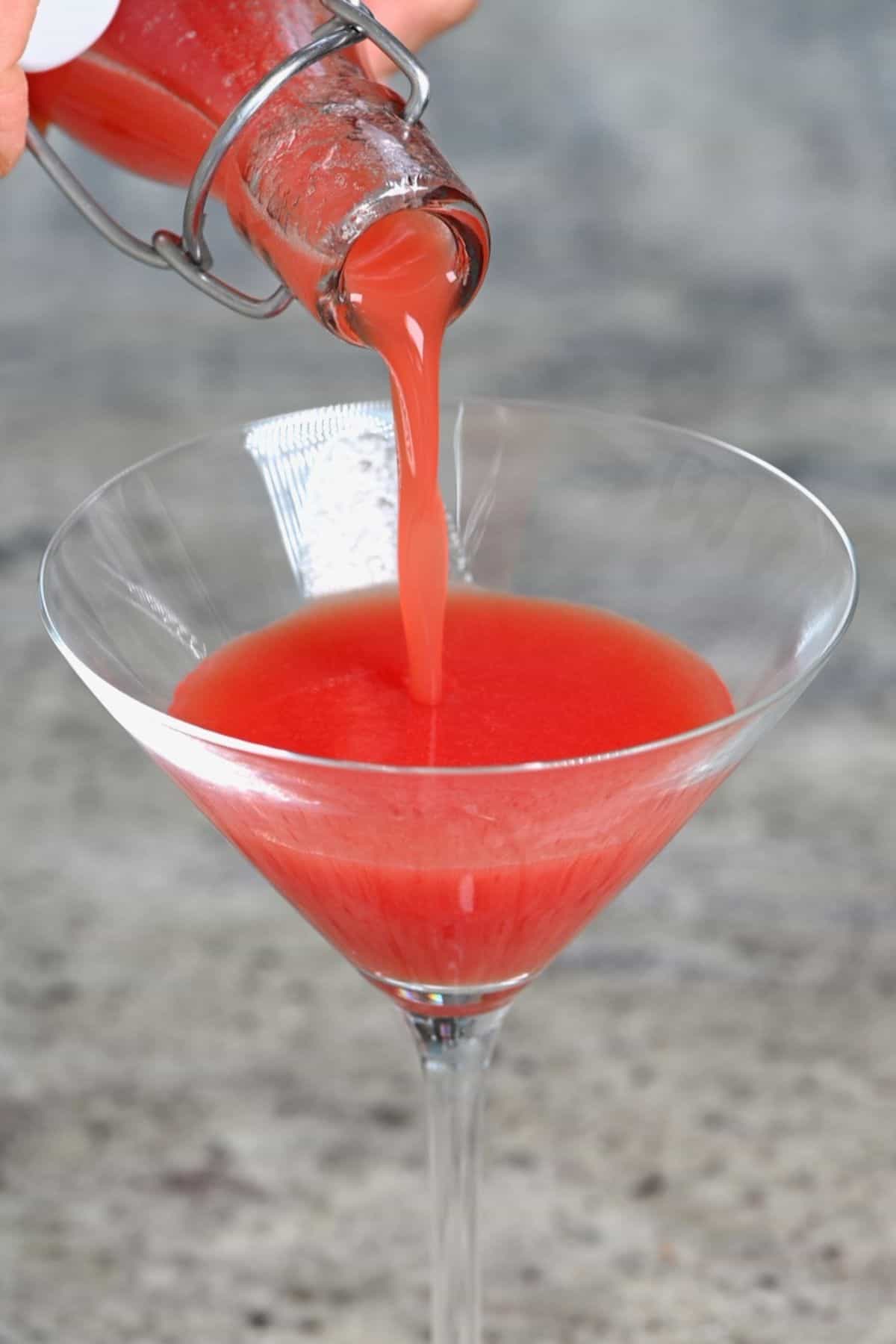
More Recipe Notes
- Choose the best tomatoes: the key to the best tomato juice is the flavor of the tomatoes that you use – so make sure to pick juicy, ripe, preferably in-season tomatoes! Avoid overripe tomatoes, those which have cracks, wrinkles, etc. I recommend going for larger tomatoes which generally contain more juice, though cherry tomatoes work too!
- Using a food mill: aside from the above methods, you can also use a food mill to extract the juice – though it may work best with softened (simmered) tomatoes. This is a method I haven't tried, so you'll have to let me know.
- Add lemon juice: Lemon juice will work as a natural preservative. It can also help certain fresh produce to maintain their color for long-term canning.
- Adding salt: One of the best things about homemade tomato juice is controlling the sodium levels, so feel free to adjust it to personal preference.
Other Healthy Juice Recipes
- Freshly Squeezed Orange Carrot Juice
- Lemon, Ginger, and Cayenne Immunity Shots
- Simple Beetroot and Ginger Juice Recipe
- Simple and Fresh Orange Juice with Ginger
- How to make Wheatgrass Shots and Juice
- Green Detox Celery Juice Blend
- Ginger Turmeric Immune-Boosting Energy Shots (juicer recipe)
If you try this homemade tomato juice recipe, I'd love to hear your thoughts/questions below. Also, I'd really appreciate a recipe card rating below, and feel free to tag me in your recipe recreations on Instagram @Alphafoodie !
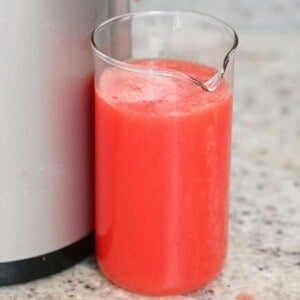
- 1.1 pound tomatoes use more or less if wanted
This would yield about 0.8 pounds/360 ml juice.
-
Wash the tomatoes well and pat them dry. Depending on which method you plan to use, you may want to remove the tomato core, too.
Tomato Juicer Recipe
-
This method is the simplest of them all and requires no manual squeezing.
Chop the tomatoes, so they fit through the chute of your juicer.
-
Slowly feed them into the juicer – voila! The juicer will automatically remove the skin and seeds from the juice.
Tomato Juice in a Blender
-
Chop the tomatoes into rough pieces.
-
Blend until the mixture is juice-like and smooth – this may take a couple of minutes to properly break down.
-
Place a large nut milk bag or layers of cheesecloth inside a large bowl (alternatively, use a sieve) and pour the tomato mixture from the blender into it. Lift the bag/cheesecloth up and allow it to drain naturally. Then, using your hands, squeeze the leftover pulp to remove as much juice as possible.
Tomato juicer with a grater
-
Grate or chop the tomato as finely as possible into a large bowl, then transfer than mixture to a nut milk bag (or cheesecloth layers) and squeeze, squeeze, squeeze.
BONUS The Heated Method
-
Chop your tomatoes and add them to a large pan on the stovetop over medium heat with a splash of water. Simmer for 20-30 minutes. Continuously stirring to soften the tomatoes.
-
Press the softened tomatoes through a sieve or food mill to extract the juice and leave behind the skin and seeds.
-
Return the extracted juice to the stovetop and heat over medium heat until just before boiling (around 185-195ºF/85-90ºC – don't boil it!).
You can then can the juice or allow it to cool slightly before transferring to the refrigerator or freezer.
How to Store?
-
Store: once prepared, fresh tomato juice can be stored in an airtight container in the refrigerator for 2-3 days.
Freeze: transfer the tomato juice to a freezer-safe container or bags, leaving 1-inch headspace (for expansion), then freeze for up to 1 year.
For small servings, you could add little portioned amounts to silicone ice-cube trays and freeze until solid. Then transfer to a freezer-safe bag/container. Then simply pop out as many cubes as needed each time.
- Choose the best tomatoes: the key to the best tomato juice is the flavor of the tomatoes that you use – so make sure to pick juicy, ripe, preferably in-season tomatoes! Avoid overripe tomatoes, those which have cracks, wrinkles, etc. I recommend going for larger tomatoes which generally contain more juice, though cherry tomatoes work too!
- Using a food mill: aside from the above methods, you can also use a food mill to extract the juice – though it may work best with softened (simmered) tomatoes. This is a method I haven't tried, so you'll have to let me know.
- Add lemon juice: lemon juice will work as a natural preservative. It can also help certain fresh produce to maintain their color for long-term canning.
- Adding salt: one of the best things about homemade tomato juice is controlling the sodium levels, so feel free to adjust it to personal preference.
- Why use the heated method? Heating them the first time will help to soften the tomatoes to extract as much juice as possible. The second heating will pasteurize the juice – it can also positively affect the juice's viscosity/texture and shelf life. More so, the flavor will change and become more concentrated. I recommend trying both methods to find your preferred version. While heating the tomatoes will reduce Vitamin C levels somewhat, the lycopene will become more easily absorbable.
For more information on how to use the tomato juice, answers to top FAQs, as well as canning advice – please read the blog post above!
Calories: 45 kcal | Carbohydrates: 10 g | Protein: 2 g | Fat: 1 g | Saturated Fat: 1 g | Sodium: 12 mg | Potassium: 591 mg | Fiber: 3 g | Sugar: 7 g | Vitamin A: 2078 IU | Vitamin C: 34 mg | Calcium: 25 mg | Iron: 1 mg
How to Make Tomato Juice With a Juicer
Source: https://www.alphafoodie.com/how-to-make-tomato-juice/
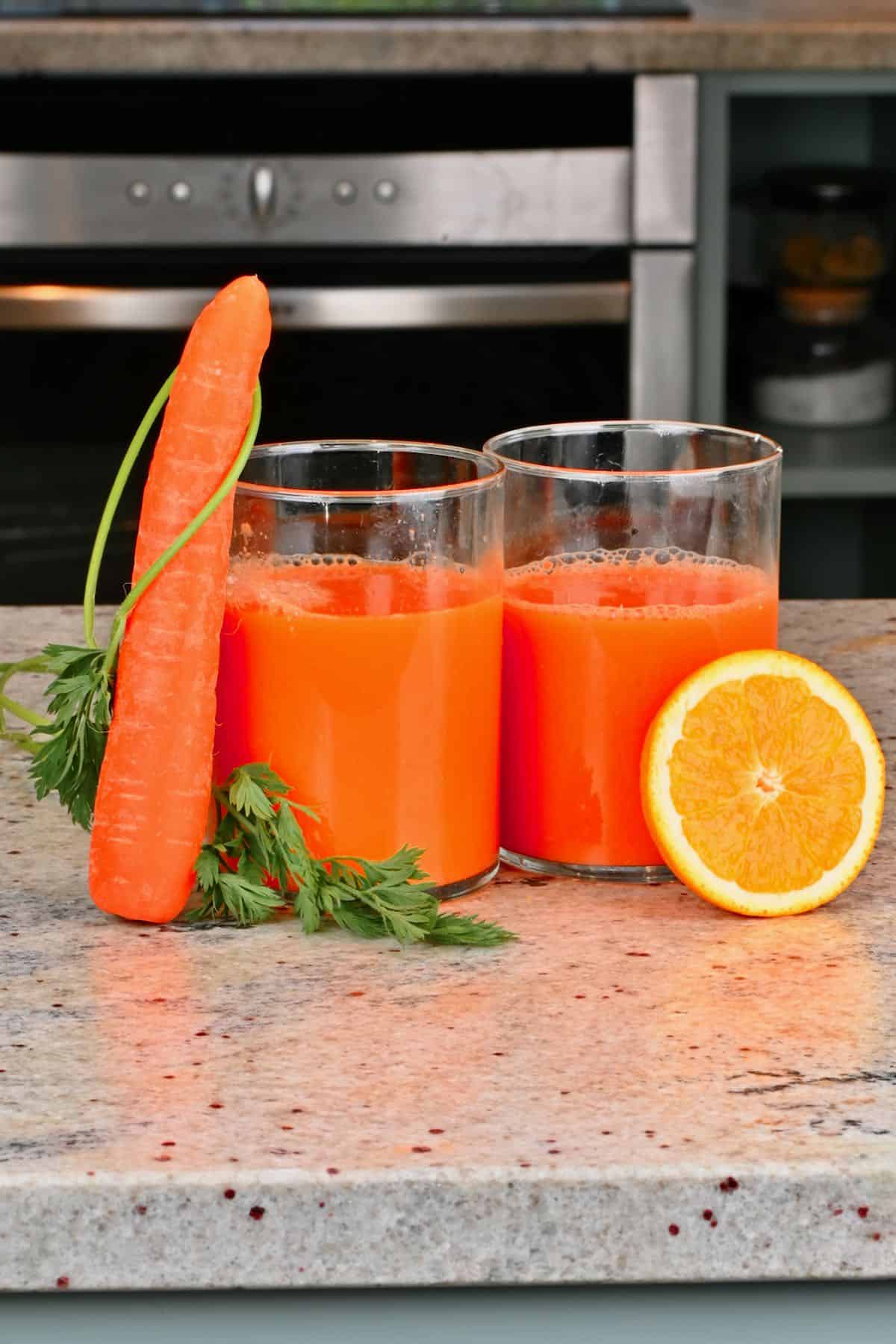
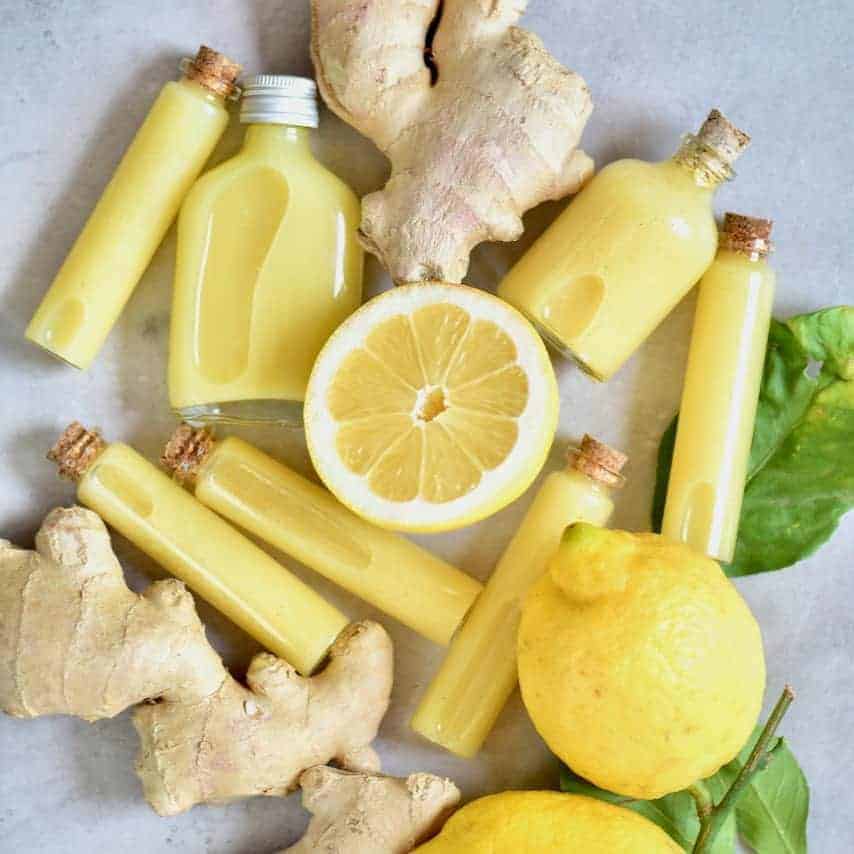

0 Response to "How to Make Tomato Juice With a Juicer"
Post a Comment